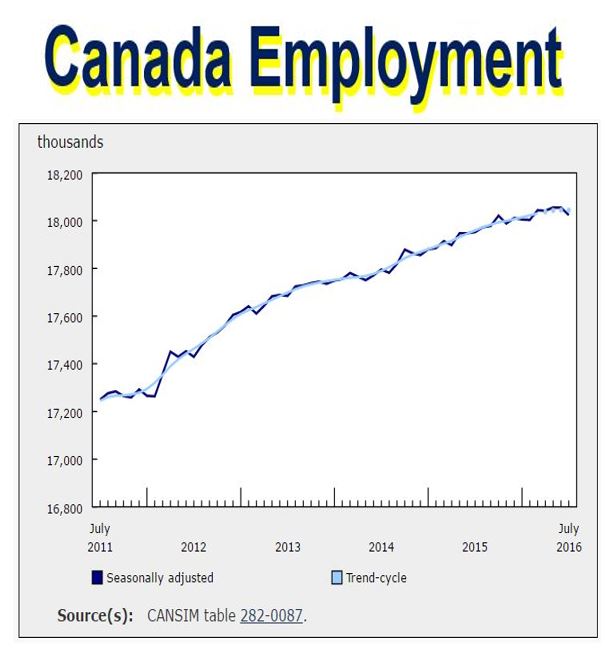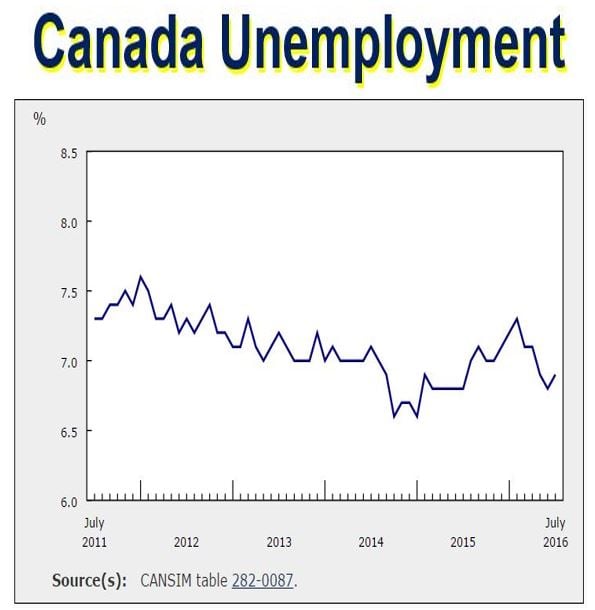Unemployment fell by -31,000 in Canada in July, an alarming setback for a nation that is struggling with the energy sector downturn. Following three months of virtually no change, July saw employment decline by -0.2%. The unemployment rate has risen by +0.1 of a percentage point to 6.9%.
Even though the number of part-time jobs from June to July increased – by +40,000 – a decline of -70,000 full time jobs added to the gloom among the nation’s workers.
According to Statistics Canada, compared with July 2015, total employment grew by +71,000 (+0.4%) – however, all the growth was in part-time positions. Over the same 12-month period, the number of hours worked increased by +0.4%.
 The recent downturn in the energy sector has had a negative effect on job prospects in Canada. (Image: statcan.gc.ca)
The recent downturn in the energy sector has had a negative effect on job prospects in Canada. (Image: statcan.gc.ca)
Employment in July fell among the youngest age group of workers – 15 to 24 years – while for the other age groups it was little changed.
Employment in the following provinces in July changed as follows:
– Ontario: declined
– Newfoundland & Labrador: declined
– New Brunswick: increased
– British Columbia: increased
– Quebec: Virtually no change
– Alberta: Virtually no change
The number of employees working in social assistance and health care increased in July, and fell in public administration.
July saw a fall in the total number of public sector employees, while private sector and self-employed worker numbers remained virtually unchanged.
Fewer youths in employment
There were 28,000 fewer 15 to 24 year-olds in jobs in July – all the losses were in part-time work. Youth unemployment in Canada now stands at 13.3%. There are -66,000 (-2.7%) fewer Canadians in this age group with jobs today compared to 12 months ago. Canada’s youth population over the same period fell by -45,000 or -1%.
 Economists had hoped that in July there would be a turnaround in Canada’s unemployment total – this was not to be. (Image: statcan.gc.ca)
Economists had hoped that in July there would be a turnaround in Canada’s unemployment total – this was not to be. (Image: statcan.gc.ca)
July saw little change in employment numbers for the 24-to 54 age group. There are thirty-nine thousand fewer women in this age group in full-time work now, while the number of women with part-time jobs increased by +38,000.
The unemployment rate for adults aged 25 to 54 stood at 5.9% in July, which was little changed on a year-over-year basis.
For men and women aged 55+, employment in July was little changed. There are now +105,000 (+6.6%) more women and 37,000 (+1.8%) more men in work compared to July 2015. According to Statistics Canada, jobs growth for this age group was driven by population growth.
Jobs lost in Ontario and gained in British Columbia
Ontario saw employment fall by 36,000 in July, the first significant drop since September last year. The unemployment rate in the province – at 6.4% – remained unchanged because fewer people participated in the labour market.
In Newfoundland & Labrador in July, employment fell by -5,000, and the unemployment rate rose by +0.8 of a percentage point to 12.8%. Over a 12-month period, employment in the province declined -4,300 (-1.8%).
British Columbia (B.C.) saw total jobs rise by +12,000 in July. The number of jobs in the province has been increasing steadily since the spring of last year. B.C’s unemployment rate fell -0.3 of a percentage point to 5.6%, the lowest rate in Canada. Since July last year, employment gains totalled +85,000 or +3.7%.
New Brunswick registered a +5,000 increase in the number of jobs for the province in July. Its unemployment rate declined by -0.6 of a percentage point to 9.7%. Since July 2015, employment in the province grew by +6,700 (+1.9%).
In Quebec, unemployment in July was little changed, the unemployment rate remained at 7%. Employment levels in the predominantly French-speaking province have remained relatively unchanged since July 2015.
Alberta saw virtually no change in July compared to the previous month. As more people are now looking for a job, the unemployment rate in Alberta is now +0.7 of a percentage point up at 8.6%, the highest rate in 22 years (September 1994).
Compared to July 2015, employment in Alberta declined by -49,000 (-2.1%), with the number of full-time jobs down -104,000 (-5.4%). Over the same 12-month period, the unemployment rate had increased by +2.4 percentage points.
Employment by sectors
– Public Administration: -24,000 fewer jobs in July, with most of the losses at local, municipal and regional level. Compared to July 2015, employment was unchanged.
– Health Care & social Assistance: +28,000 more workers employed in July, with year-over-year gains totalling +64,000 (+2.8%).
– Public Sector Employment: up by +42,000 in July. There was very little change among self-employed and private sector workers. The public sector includes some workers in health care & social assistance, and education, all workers in public administration, as well as most employees in utilities.
Compared with July 2015, public sector employment was down by -40,000 (-1.1%). The number of private sector workers rose by +103,000 (+0.9%). The number of self-employed workers over the same period was little changed.
Fort McMurray Wildfire
Data for the Wood Buffalo area was not collected from May to July because of the giant wildfire that has affected northern Alberta.
Statistics Canada said that for Wood Buffalo, it extrapolated from data gathered from surrounding areas. As Wood Buffalo only represents 2% of Alberta’s population, “The impact of this interruption in data collection is minimal on provincial estimates and negligible on national estimates,” Statistics Canada said.
Video – Weak July Job Figures: Canada

